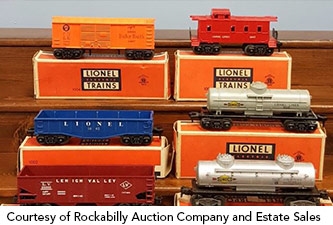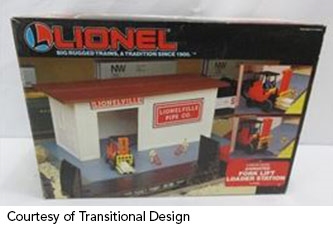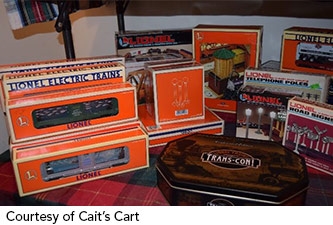Collecting Lionel Trains
 Header photo courtesy of Pace & Hong Auctions
Header photo courtesy of Pace & Hong Auctions
Trains are an undeniable emblem of the holiday season. From tracks laid ‘round the base of a tree, to the popular book The Polar Express, the chug of the engine and that unmistakable whistle indicate a shipment of halcyon memories of Christmases past pulling into the station.
And it was all engineered by one man with a great idea.
Joshua Lionel Cowen (born Cohen), a businessman, inventor, and marketer, convinced toy store owners that model trains would be the perfect addition to their store windows. America's fascination with railroads, combined with the train's main job of delivering goods (i.e. toys and gifts) made the department store display the perfect medium for Cowen's playful industrial art. Though they were initially intended for display only, shoppers very quickly caught on that electric trains would make great gifts, and soon enough a tradition was born.
Cowen knew he had something special on his hands, and he built a century-spanning business on the wonder of railroad technology.

Since the 1900s, Lionel Trains chugged their way into the hearts of kids and adults alike. But they’re not a part of contemporary childhood anymore—not like they once were. “There are so many more distractions for kids today,” Bill Schmeelk of the Lionel Collectors Club of America said. “It’s really a declining hobby.”
It’s a heartbreaking fact. But in their golden years, Lionel trains were popular and prolific. And some of those children who grew up playing with them are now collecting those little pieces of their childhood.
The history of Lionel Trains are generally split into three specific eras. Collectors tend to focus on the eras in which they were raised. Some more popular than the others.
Era's of Lionel Trains
Pre-War
The Pre-War era, which lasts from the company’s 1900 inception up to the beginning of World War II, when Lionel’s toy train production was put on hold.
Which means, because WWI occurred during Lionel’s early years, it’s really a pre-war, wartime, post-war, pre-war era, if you want to get technical.
Which I do. I really do. Everyone ready to hop on the PWWPWPW Era bandwagon?
No?
Fine.
What if it’s a train, rather than a wagon?
Still no?
Fine.
Cowen’s first train, theElectric Express, ran on metal tracks and was driven by a small electric motor between its wheels. The battery-powered one-speed motor could run for nearly 15 hours.
The trains evolved over the years, moving from a wooden design to one of tin. Some pre-War trains also were larger than later era models, running on 3-rail standard-gauge tracks rather than the now prevailing O-gauge.
“Gauge” refers to the distance between the outside rails of the track. O-gauge, for example, is 1-¼” between rails, and S-gauge, which runs smaller trains, is ⅞”. Check out Lionel’s website for a full explanation of differences between all the different gauge sizes. O- and S- may be the most common, but they’re certainly not the only sizes.
This was also the era of Lionel’s most popular—and expensive—train: the New York Central Hudson 700E. “It was a mass-produced but scale locomotive,” Schmeelk said, “even the right number of rivets and everything.” But, such detail came at a cost. “When it came out it was $75,” Schmeelk said. “which was a lot of money in the 30s.”
One could argue that $75 is still a lot of money, but that’s a different blog for a different time.
The Hudson 700E was blueprint-accurate, unlike others up to this point. This began a trend that would be the calling card of Lionel in the period known as…
Post-War
The far more appropriately-named post-War era begins at the close of WWII, and ends around 1969. As World War II raged, the company shifted its focus from toy trains to defense production. Once the war was over, they returned to what they knew best, but with a few changes.
The era of tin trains was essentially over at this point—they were phased out by 1943. This is also the era of entirely O-gauge trains—Lionel discontinued making standard-gauge in the late 1930s.
The next few decades saw several innovations from Lionel, including the addition of an automatic knuckle coupler, which is a more authentic way of connecting trains than the up-until-that-point standard latch hook. The company also introduced a steam locomotive that puffed smoke, thanks to an ammonium nitrate pellet in the train’s headlight.
The company focused on accuracy, and on making their trains identical to their full-sized counterparts. The trains that flew through cities and towns across America could also fly through living rooms and basements, at a miniaturized scale.
Cowen sold his shares of the company in 1959 to a distant relative, as did his son, Lawrence. Cowen passed away six years later.
The Modern Era
This period, which extends all the way through to the present day, could be split up several times, as the company changed hands more than once after Cowen sold his shares. The MPC/General Mills Era, the Richard Kughn Era, and the Wellspring Era are all subsets of the very large “Modern Era.” During parts of the modern era, specifically the MPC/General Mills period, the quality standards were not at the same level as pre-and post-war manufacturing. Later periods saw a return of quality, but interest in those trains were never as high as when Cowen was in charge.
So as far as collectors are concerned, it seems, it’s the pre-and post-war eras that are of the most interest. “Right now, the largest group of collectors is 55 and up,” Schmeelk said, and those collectors grew up with pre- and post-war trains. They turned away from childish things, only to return in their later years, when they had the time, space, and money to enjoy them again.
And estate sales and auctions are a great place to find your vintage locomotives. But there are a few things to consider.
Considerations When Collection Lionel Trains
Quality

For vintage trains to have value, Schmeelk said, they must be in excellent condition. “When Lionel made them, they made tens of thousands,” he said. “They’re not rare, but they’re hard to find in mint or excellent condition.”
Schmeelk suggests paying close attention to how the trains were stored. A box full of trains, he said, is indicative of a former owner who didn’t put much effort into maintaining them. If they’re packed away in their original boxes, or otherwise well kept, you’re more likely to have found something that will run.
And those original boxes, of course, increase the value considerably.
But not all trains were created equal. And not just from era-to-era. Locomotives of varying quality were sold throughout each era. “Lionel did make some bottom-of-the-line models,” Schmeelk said, emphasizing that this hobby, even before the collector’s market, was not an inexpensive one. But the varying quality and price points made it more accessible to others.
But toy trains of any original retail price are fun, as long as they're functioning. If they are well cared for, Lionel trains can have a long life. So be sure to look over your trains carefully for wear, and particularly for rust around the wheels and contacts, which greatly affects the value and functionality of the trains.
Parts

Vintage trains can be valuable, as can the accessories. But beyond these parts, it doesn’t behoove a collector to shop vintage. Searching for old tracks and transformers, Schmeelk said, is for the most part a pointless endeavor. “Track and transformers have little value, because track is still made today, and old track is troublesome if you’re making a layout,” Schmeelk said. Standard track and O-gauge are both still made today. “It’s manufactured by several different companies,” Schmeelk said.
Older transformers, too, are rarely of value, Schmeelk said. They may have cords or internal wiring that have hardened or cracked, and Lionel repair stations aren't authorized to repair them. "Since we are dealing with 120 volts, they should only be serviced by someone qualified to service electrical products," Schmeelk said. "All of Lionel’s other products runs at 18 volts or less."
Variations / Reproductions

Lionel collectors of any era will never run out of pieces to covet. Sure, their production line was prolific, so it will take a while for a collector to amass everything he or she may want. But the company also occasionally released items that weren’t mass produced. These pieces can be easy to identify by those who are well-versed in Lionel history. “It’s very obvious to tell what’s not a production item because it will be in a different color, or will have different stamping,” Schmeelk said. But to the uninitiated, this can be a problem. Lionel Trains, like any other collector’s items, are no stranger to reproductions. There was one specific and insidious incident that can be difficult to identify if one is not cautious, because it uses the Lionel trains themselves. “It was discovered that somebody was taking the plastic shell [of the Lionel Train], and they had a concoction that they were able to dip it in and change the color,” Schmeelk said. “They were selling it as a rare variation. That went on for a while.”
Other variations aren’t as obvious to spot. Schmeelk spoke about a passenger car that was altered for easier production after the first year. The company discovered a change in the size of the car’s doors would make the manufacturing process much easier, so they made the switch. “Most of those you see have the smaller doors,” Schmeelk said. “So when one shows up with the larger door, that was only made for one year, and it has much more value than the common version.”
“That’s the kind of thing that a person who just finds a set of trains has no idea about,” he said. But guidebooks are available to help. Greenberg’s Lionel Trains Pocket Price Guide 1901-2017, for example, is an affordable primer on every O-gauge and standard-gauge train Lionel has made, with values based on condition. Greenberg also produced a pricier book focusing solely on older-model trains, Greenberg's Guide to Lionel Standard and 2-7/8" Gauges, 1901-1940, for those only interested in pre-War models.

But Schmeelk warns that if you are buying with the intention of reselling, the guides aren’t a good indication of how much you can expect to get. “If they’re selling it to a dealer, they can really only expect to get maybe half the posted value,” he said.
But most collectors are doing it for the love of the trains, and the nostalgia they bring, not the potential resale value.
“Today, it seems to be going more into the direction of people operating the trains,” Schmeelk said, rather than keeping them boxed up or displayed on a shelf. “There was a period in the 70s and 80s where people were just collecting. But there are some people out there with fantastic layouts now.”
Despite its declining popularity with youngsters, Schmeelk says an electric train set remains an excellent source of learning. "Children develop both electrical and mechanical skills in addition the the skills developed while adding scenery to a layout," he said. "For a child’s interest to develop, he needs an involved parent to help expand a basic train set."
The potential for enjoyment and creativity is limited only by your imagination, and the time and effort you’re willing to put into it.